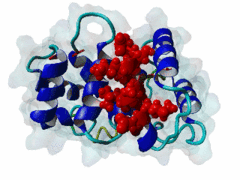| Accession: | |
|---|---|
| Functional site class: | N-myristoylation site |
| Functional site description: | Myristate attached to an N-terminal glycine residue acts as a membrane anchor for some soluble cytoplasmic proteins. |
| ELM Description: | Generic motif for N-Myristoylation site. |
| Pattern: | ^M{0,1}(G)[^EDRKHPFYW]..[STAGCN][^P] |
| Pattern Probability: | 0.0000250 |
| Present in taxons: | Arabidopsis thaliana Dictyostelium discoideum Drosophila melanogaster Eukaryota Homo sapiens Mus musculus Plasmodium falciparum Schizosaccharomyces pombe |
| Interaction Domain: |
NMT_C (PF02799)
Myristoyl-CoA:protein N-myristoyltransferase, C-terminal domain
(Stochiometry: 1 : 1)
|
Myristoyl-CoA:protein N-myristoyltransferase (EC 2.3.1.97) (NMT) covalently transfers a myristate group to an N-terminal glycine residue. The N-terminal methionine must therefore be cleaved away. The attached lipid moiety can act as a membrane anchor. The Src oncoprotein is a well known example of an N-myristoylated protein. |
(click table headers for sorting; Notes column: =Number of Switches, =Number of Interactions)
Please cite:
ELM-the Eukaryotic Linear Motif resource-2024 update.
(PMID:37962385)
ELM data can be downloaded & distributed for non-commercial use according to the ELM Software License Agreement
ELM data can be downloaded & distributed for non-commercial use according to the ELM Software License Agreement

